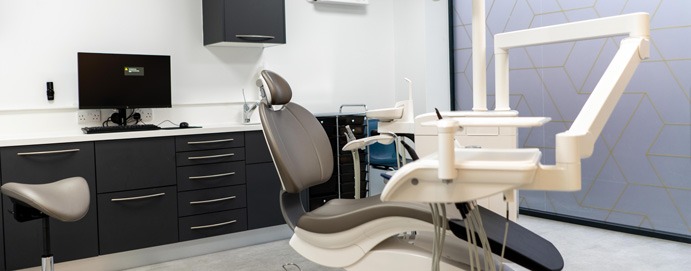Creating a calming and quiet environment in a dental clinic is crucial for both patient comfort and staff productivity. High noise levels in dental offices can lead to stress, anxiety, and discomfort for patients, which in turn can affect the quality of care. A well-designed dental office with appropriate soundproofing features can make a significant difference in enhancing the overall experience. In this blog, we will explore practical soundproofing ideas that can transform your dental clinic into a quieter, more comfortable space.
Why Soundproofing Matters in a Dental Clinic
The dental office design plays a significant role in creating a positive atmosphere for both patients and practitioners. Dental clinics often have a variety of noisy equipment, from high-pitched drills to air compressors, all contributing to an environment that may induce stress or anxiety in patients. Moreover, the noise can disrupt the workflow of dental professionals, affecting their focus and performance.
Soundproofing your dental clinic is more than just reducing noise; it’s about creating a peaceful space that promotes relaxation, enhances communication, and ensures a more pleasant environment for all. Whether you’re building a new clinic or looking to renovate an existing space, it’s essential to consider how soundproofing can elevate the patient experience and improve operational efficiency.

Key Considerations When Soundproofing Your Dental Office Design
When planning the soundproofing of your clinic, you’ll need to focus on three main areas: walls, floors, and ceilings. Each of these components can contribute to noise reduction, and integrating them into your overall dental office design will provide the best results.
1. Acoustic Insulation for Walls
Walls are one of the most significant contributors to sound transmission, especially in dental clinics where equipment noises can travel easily between rooms. To reduce noise, installing acoustic insulation in your walls is crucial. Materials such as soundproof drywall, fiberglass batt insulation, or foam panels are ideal for blocking sound and reducing the transmission of noise between rooms. You can also add a layer of mass-loaded vinyl (MLV) between the drywall to further enhance soundproofing.
For additional noise reduction, consider using double-layered drywall with a sound-dampening material sandwiched between them. This method significantly improves the overall acoustics and prevents noise from traveling to neighbouring rooms, especially important in treatment areas and waiting rooms.
2. Flooring Solutions for Noise Control
Flooring is another area that can help reduce noise in a dental clinic. Hard floors such as tile, concrete, and wood can contribute to higher noise levels due to sound reflection. Carpet or cushioned vinyl flooring can reduce the amount of noise generated from footsteps and equipment movement, providing a softer and quieter feel to your dental office.
If carpet is not suitable for your clinic due to cleaning and hygiene concerns, consider high-quality rubber flooring, which not only reduces noise but also provides excellent durability and comfort underfoot. Another option is cork flooring, which has natural sound-absorbing properties and can enhance the overall acoustic quality of your dental office design.
3. Ceiling Treatments to Absorb Sound
The ceiling is another critical element in reducing noise levels. Installing sound-absorbing ceiling tiles can dramatically improve the acoustics of your clinic. Acoustic ceiling tiles are designed to absorb sound and prevent echoes, which can be a common issue in open-plan spaces such as waiting areas or treatment rooms.
Consider installing a drop ceiling system with acoustic tiles, which can help absorb sound and prevent it from bouncing around the room. This is especially beneficial in larger dental clinics with multiple treatment areas where sound can travel across rooms. Alternatively, acoustic baffles or panels can be suspended from the ceiling to control noise, creating a more peaceful and controlled environment.
4. Strategic Use of Soundproofing Doors and Windows
Doors and windows are often overlooked when considering soundproofing, but they can be significant contributors to noise pollution in a dental clinic. Using solid-core doors instead of hollow ones can make a big difference in reducing sound transmission between rooms. Ensure that doors are properly sealed with high-quality weather stripping to prevent sound from leaking through gaps.
Windows can also be a source of noise infiltration, especially in urban locations where traffic noise is prevalent. Double-glazed or laminated windows are excellent at blocking external sounds and providing a quieter indoor environment. If replacing windows isn’t an option, consider adding heavy curtains or acoustic window inserts to further dampen noise.
5. Strategic Layout and Room Partitioning
The layout of your dental clinic plays a key role in minimising noise disruption. For example, placing noisy equipment or treatment areas at the back of the clinic, away from the waiting area or consultation rooms, can help to reduce noise exposure for patients. Using soundproof room dividers or partitions can also help separate spaces and keep noise from spreading.
Ensure that high-traffic areas, such as corridors, are designed in a way that minimises sound transmission. Avoid placing heavy equipment near walls that share common spaces like waiting rooms or offices. If possible, create a buffer zone between treatment areas and the more public spaces to isolate and control noise levels.
Additional Tips for Creating a Quieter Dental Environment
- Soundproofing Materials for Equipment: Some dental equipment, such as compressors and suction systems, can generate significant noise. To reduce this, consider investing in equipment that features noise-reducing technology or enclosures that muffle sound.
- White Noise Machines: If achieving complete soundproofing is not possible, using white noise machines can be an effective solution. These devices generate a consistent sound that masks other noises, helping to create a more relaxing environment for patients.
- Soundproof Furniture: Incorporating soft materials in your furniture, such as upholstered chairs in the waiting area or treatment rooms, can absorb sound and reduce noise levels.

Working with Dental Surgery Contractors for Effective Soundproofing
When undertaking a dental office design or renovation, it’s essential to partner with experienced dental surgery contractors who understand the unique acoustical requirements of a dental clinic. These professionals can help you select the best soundproofing materials and solutions tailored to your clinic’s layout, ensuring that the final design meets both aesthetic and functional needs.
Dental surgery contractors are also well-versed in the technical aspects of soundproofing, such as proper insulation installation, soundproofing of HVAC systems, and ensuring compliance with health and safety regulations. They will guide you through every step of the process, from the initial consultation to the final installation, to ensure that your clinic meets the highest standards for patient comfort and noise reduction.
Conclusion
Soundproofing is an often overlooked but essential aspect of dental office design. By incorporating strategic soundproofing solutions into your clinic’s walls, floors, ceilings, and overall layout, you can create a quieter, more relaxing environment for both patients and staff. Investing in soundproofing materials and working with experienced dental surgery contractors will ensure that your clinic remains a peaceful sanctuary, reducing anxiety and improving the overall patient experience.
For any dental office renovation or design needs, consider reaching out to Divo Interiors Ltd for expert guidance and execution of soundproofing solutions tailored to your specific requirements.
















